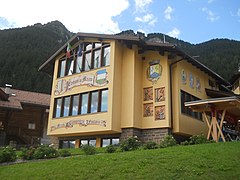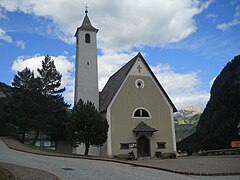Mazzin
| Mazzin | ||
|---|---|---|

|
|
|
| Country | Italy | |
| region | Trentino-South Tyrol | |
| province | Trento (TN) | |
| Local name | Mazin | |
| Coordinates | 46 ° 27 ' N , 11 ° 42' E | |
| height | 1395 m slm | |
| surface | 23.63 km² | |
| Residents | 585 (Dec. 31, 2019) | |
| Population density | 25 inhabitants / km² | |
| Factions | Campestrin, Fontanazzo, Fontanazzo di sopra, Mazzin | |
| Post Code | 38030 | |
| prefix | 0462 | |
| ISTAT number | 022113 | |
| Popular name | Mazzinesi | |
| Patron saint | Santa Maria Maddalena (July 22nd) | |
| Website | www.comune.mazzin.tn.it | |
Mazzin ( Ladin Mazin ; German outdated Matzin ) is an Italian municipality with 585 inhabitants (as of December 31, 2019) in the province of Trento, east of the Rosengarten . The seat of the municipal administration is the district of Fontanazzo . The patron saint of the place is St. Mary Magdalene . Mazzin belongs to the valley community Comun General de Fascia .
Surname
The place name Mazzin probably comes from the Latin "Macinus" and translated means "mill".
geography
Mazzin is located about 64 km north-northeast of Trento in Val di Fassa on the orographic right side of the Avisio at 1395 m slm at the confluence of the Val Udai . The municipality is surrounded by several Dolomite groups , such as the Marmolada in the east and the Rosengarten group in the west . The municipality covers an area of 23.63 km². Neighboring communities are Canazei , Campitello di Fassa and San Giovanni di Fassa as well as the South Tyrolean community of Tiers . The Antermoia hut and the Antermoia lake are located in the municipality .
Administrative division
The three fractions Campestrin, Fontanazzo and Fontanazzo di sopra belong to Mazzin .
history
The place became famous in the 1960s through the discovery of important remains of settlements of Raetian origin dating from the 4th to 5th centuries BC. Come from BC. At the excavation site at "Doss dei Pigui", on the left bank of the Avisio , the remains of an ancient fortress, bronze implements, weapons and jewelry were found that are now kept in the Ladin Museum in Vigo di Fassa . The historic center of Mazzin has some frescoed buildings of historical interest.
Village of the Pitores
Mazzin is also known as the “village of the Pitores” (Italian: Il paese dei pitores ) and has a centuries-old tradition of handicrafts that is still alive today. The Pitores (German: painter) from Mazzin were artisans such as decorative painters and painters in the field of rural painting . Many villages and valleys in Ladinia developed a specific art and craft tradition by the 18th century at the latest. They moved out in search of work since the second half of the 18th, but especially since the early 19th century, to work as traveling painters (also painters on the sturgeon or sturgeon painter) elsewhere on facades, cabinets , furniture such as chests , everyday objects, but also to paint churches. A greenish to blue primer on which - mostly in a mixture of red and white shades - flower buds, rosebuds and other floral motifs, birds, rural motifs, religious monograms and the like are painted in egg or casein tempera is characteristic of Fassan's furniture painting . The motifs are clearly executed with a few, often pale colors. A strong cobalt blue , also known as "Fassaner blue" , is often characteristic and dominant . Traces of painters from Fassa were found throughout the former Austro-Hungarian monarchy , in Switzerland and in Bavaria. Between the two world wars, handicraft production came to a standstill under the poor economic conditions. Today you can find examples of Fassaner furniture painting in the Museum Ladin Ćiastel de Tor and in the Tyrolean Folk Art Museum . In Mazzin itself, in addition to the frescoes on the Casa Battel, you can see other examples of Fassa painting on house facades and in the church of Maria Magdalena.
Culture and sights
Casa Battel
Mazzin the only example of an intact, country-manor is peasant fortress of the entire Fassa receive: the "Casa Battel" (from ital. Casa : House, also called "Cèsa / Ciasa Battel" and "Casa / Cèsa / Ciasa Cassan," "guest house zum Schwarzen Mann "or colloquially Castello or the castle) was built in the 15th century and fortified in the 16th century, and has a gable tower and decorations and frescoes of considerable artistic value. Of particular interest are the decorations on the corners and around the doors and windows. The year 1785 is decorated on the north door. To the south, facing the main street, the inscription "Gasthaus zum Schwarzen Mann, Jakob Cassan" was added in the 19th century. On the building there are religious frescoes: a Mariahilf Madonna with child, saints and poor souls with Saints Veronica and Antonius of Padua (1791); two illustrations by Johannes Nepomuk and Saint Florian (1791); another Madonna and Child, Anthony of Padua and Saint Juliana (17th century); and another painting depicting John the Baptist (17th century). The name Battel goes back to a long-established family in the Fassa Valley, verifiable since at least the 17th century. The name Cassan and the designation "to the black man" go back to the dark-skinned trader Jakob Cassan, who came from Africa and who worked in the 19th century . ran a tavern in the building .
The prisons of Casa Costazza
North of the "Casa Battel" is the building "Casa Costazza" (from Italian Casa : house) with traces of wall decorations on the east and south facades. There is an inscription on the east door and the year 1518 on the portal. It is one of the oldest examples of all masonry buildings in Val di Fassa. The building was the old seat of the episcopal vicar and the Fassa prisons.
Maria Magdalena Church / Santa Maria Maddalena
The Maria Magdalena / Santa Maria Maddalena church is located on the side of the SS48 state road , decentralized to the village. The church was built in 1573, consecrated in 1582 and expanded in 1894. The bell tower was raised in 1923 with the addition of a second bell tower. The church has a steep roof and a bell tower with a pyramidal top. Gothic windows open on the sides. The cross on the gable shows the year of the last expansion (1894). The interior consists of a nave and an apse with a ribbed vault . The high altar dates from the middle of the 18th century and is made of multi-colored wood and artificial marble. The statues of St. Bishop and St. Nicholas are on shelves . The tabernacle bears the statues of John the Baptist and Evangelist. There is an oil altar painting with the Holy Family on the altar substructure . The right side altar is a wooden altarpiece dated 1730 with a statue of St. Anthony with child. Outside there are two other statues of Saints Peter and Paul . The left side altar dates from 1663 and is dedicated to St. Anthony of Padua; outside on the left is a statue of St. Mary Magdalene and on the right the statue of the Holy Bishop. The skilfully carved antependium has two side niches with sculptures of Saints Peter and Paul. In the triumphal arch there are 15 polychrome wooden bas-reliefs from the 17th century depicting the rosary mysteries. To the left of the hall is an oil painting from the 19th century ( Saint Joseph with child, Florian and angels). The canvases of the 14 Stations of the Cross of Jesus date from 1815 and are the work of local artists.
In the bell tower there are 3 bells, two of which were cast in Varese in 1922 by the Bianchi foundry, while the central bell is a precious piece of rare craftsmanship by the famous Chiappani family of bell-makers from Trento in 1913. The notes of the bells are F # 3, Re4 and Mi4.
photos
Web links
Individual evidence
- ↑ Statistiche demografiche ISTAT. Monthly population statistics of the Istituto Nazionale di Statistica , as of December 31 of 2019.
- ↑ a b Mazzin - Campestrin - Fontanazzo. Val di Fassa Tourist Board, accessed on 23 September 2018 .
- ^ Alberto Alberti: Osservazioni sul Doss dei Pigui. In: Institut Cultural Ladin (ed.): Archeologia nelle Dolomiti . 1993 (Italian, academia.edu [accessed September 22, 2018]).
- ↑ a b craft | Museum lady. Retrieved September 22, 2018 .
- ^ A b Karl C. Berger: A chest in the museum. In: Upper Austrian State Museum. Tiroler Landesmuseum Ferdinandeum, accessed on September 20, 2018 .
- ^ Alois Rastner: Heimatbuch Rodeneck. In: Digitized holdings of the State Library Dr. Friedrich Teßmann. 1986, accessed on September 24, 2018 (mention of the name, 17th century).
- ^ Local newspaper Trentino (ed.): Mazzin, è in vendita la casa "dell'Uomo nero" . (Italian, giornaletrentino.it [accessed September 22, 2018]).
- ↑ Death picture of Cassan Giacomo Antonio (born 1845). In: Death pictures all of Tyrol North, East and South Tyrol. Retrieved September 24, 2018 .





